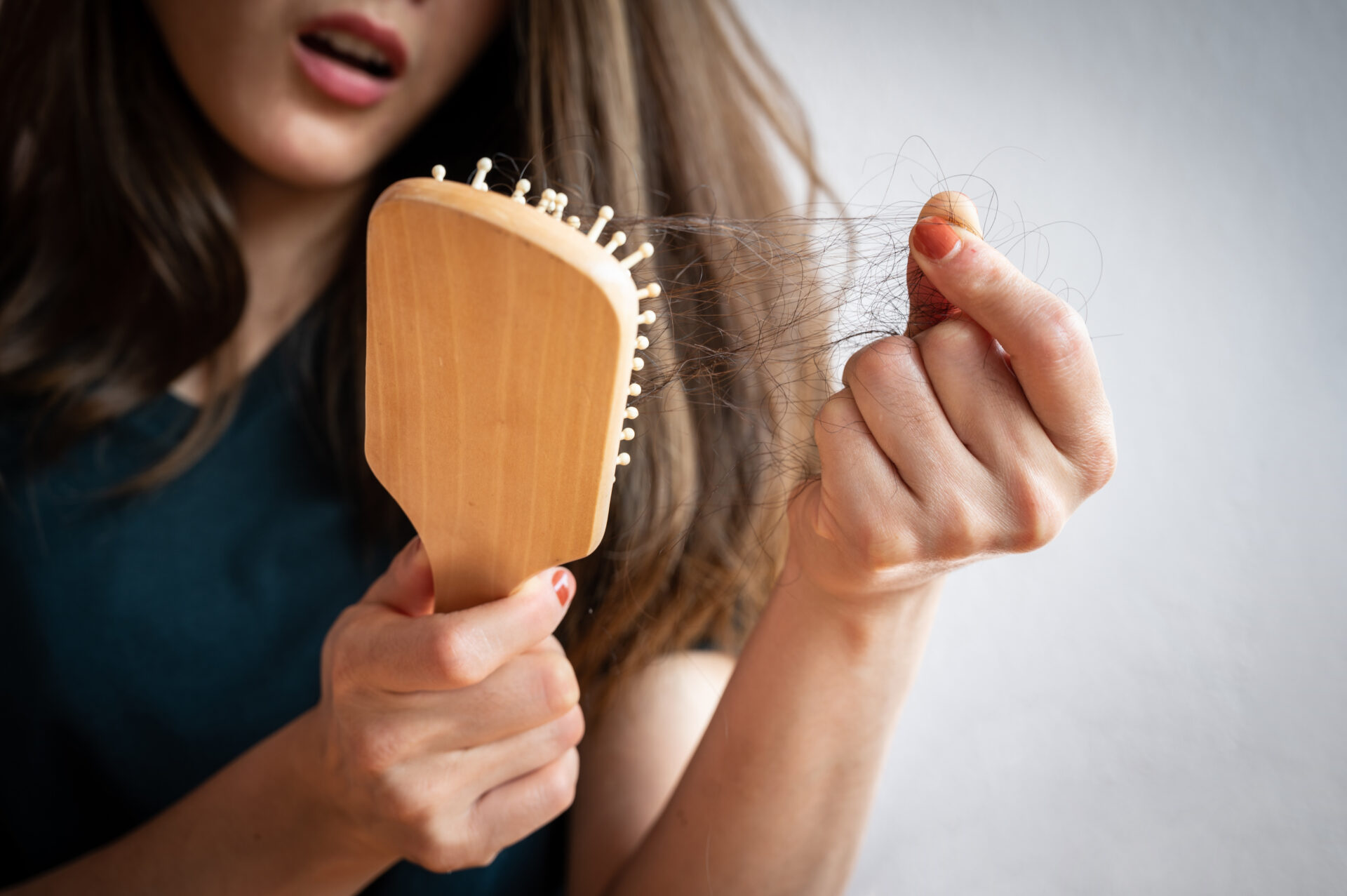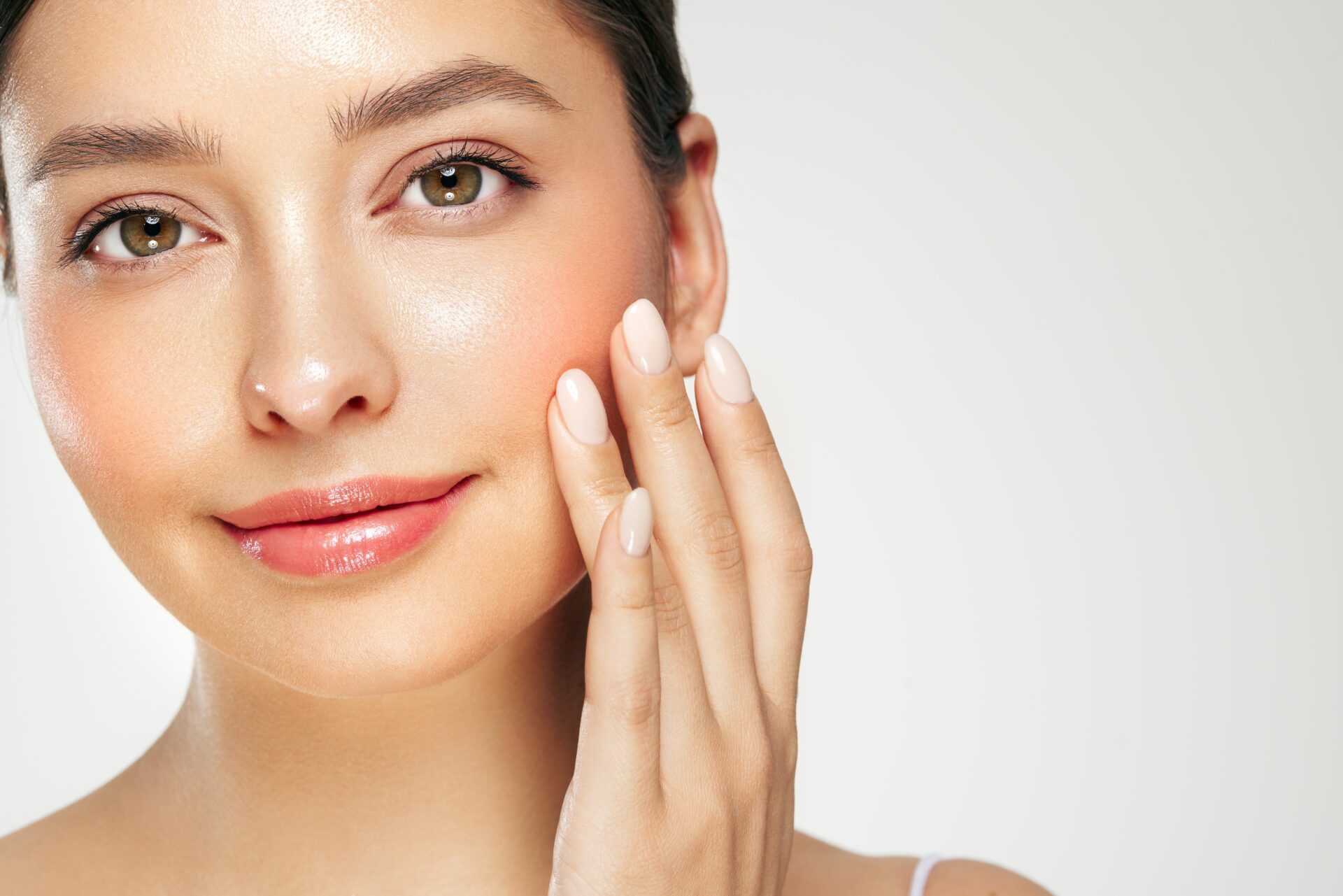Hair loss during menopause is one of the most distressing changes women experience during this life transition. While many women expect hot flashes and mood changes, the gradual thinning of hair often comes as a shock, impacting self-confidence and requiring a comprehensive understanding of both causes and solutions.
Keep reading to discover the science behind menopausal hair loss and learn about the comprehensive treatment approaches that can help you maintain healthier, fuller hair during this important life stage.
Why Does Menopause Trigger Hair Loss?
The primary culprit behind menopausal hair loss is the dramatic shift in hormone levels that occurs during this transition. As estrogen and progesterone levels decline, the protective effects these hormones have on hair follicles diminish significantly.
Declining Estrogen Levels
Estrogen helps keep hair in the anagen (growth) phase for longer periods, promoting thicker, fuller hair. When estrogen levels drop, hair follicles spend less time in the growth phase and more time in the resting phase, leading to shorter, thinner hair strands that are more likely to fall out.
Increased Androgen Activity
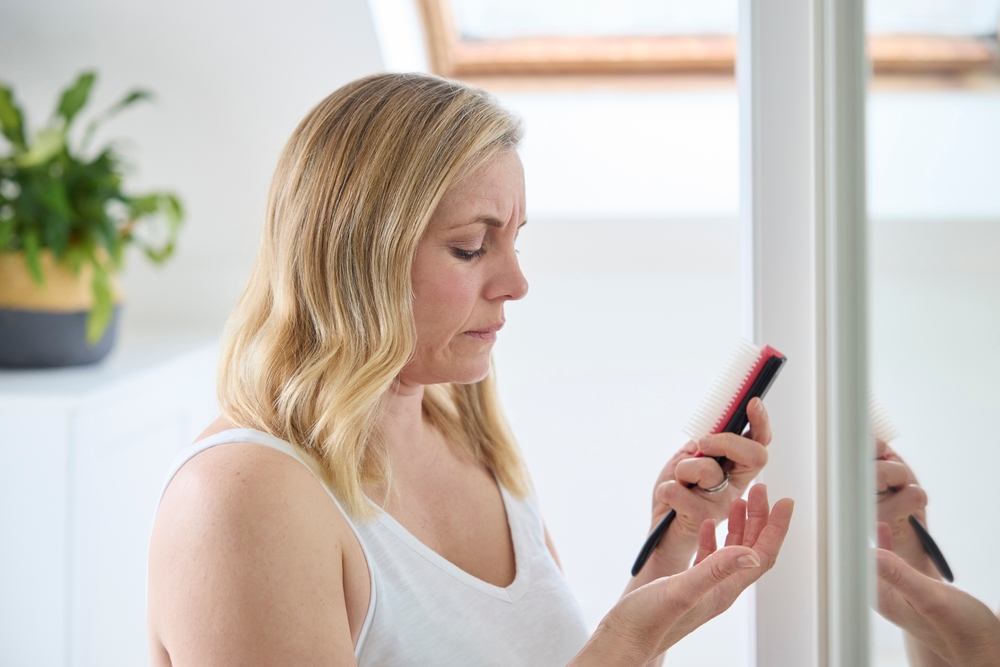 While declining estrogen is a major factor, the relative increase in androgens (male hormones) also plays a crucial role in menopausal hair loss. During menopause, while overall hormone production decreases, the ratio of androgens to estrogen increases.
While declining estrogen is a major factor, the relative increase in androgens (male hormones) also plays a crucial role in menopausal hair loss. During menopause, while overall hormone production decreases, the ratio of androgens to estrogen increases.
These androgens, particularly dihydrotestosterone (DHT), can cause hair follicles to shrink in a process called miniaturization. This leads to progressively thinner hair strands and eventually to follicles that stop producing hair altogether, particularly around the crown and temples.
Scalp Aging and Reduced Circulation
Beyond hormonal changes, the aging process itself affects the scalp environment in ways that can accelerate hair loss. The scalp skin becomes thinner and less elastic with age, reducing blood flow to hair follicles and limiting the delivery of essential nutrients.
Collagen production in the scalp decreases over time, weakening the structural support around hair follicles. This compromised scalp environment creates additional challenges for maintaining healthy hair growth, making targeted scalp treatments an essential component of comprehensive hair loss management.
What Are the Different Types of Menopausal Hair Loss?
Androgenetic alopecia, also known as female pattern baldness, is the most common type of hair loss experienced during menopause. This condition typically manifests as diffuse thinning across the crown of the head rather than the receding hairline pattern seen in men.
Telogen effluvium is another type of hair loss that can occur during menopause, characterized by widespread hair shedding following physical or emotional stress. The hormonal upheaval of menopause itself can trigger this type of temporary hair loss, though it may become chronic if underlying causes aren’t addressed.
Dr. James Kilgour at Golden State Dermatology explains the complexity of menopausal hair loss:
“Many women don’t realize that menopausal hair loss involves multiple factors working together – declining estrogen, increased androgen sensitivity, and changes in scalp health all contribute to the problem. I often see women who have tried single-approach treatments without success, when what they really need is a comprehensive plan that addresses hormonal, nutritional, and scalp health factors simultaneously. The key is recognizing that effective hair loss treatment during menopause requires patience and a multi-faceted approach.”
What Medical Treatments Are Available for Menopausal Hair Loss?
Minoxidil remains the most widely prescribed topical treatment for female pattern hair loss and can be particularly effective when started early in the hair loss process. This FDA-approved medication works by extending the growth phase of hair follicles and increasing blood flow to the scalp.
Hormone replacement therapy may also help some women experiencing menopausal hair loss, particularly when estrogen and progesterone levels are restored to more optimal ranges. However, the decision to pursue hormone therapy should always involve careful consideration of individual risk factors and benefits with a qualified provider.
However, professional scalp treatments can play a vital role in creating an optimal environment for hair growth during menopause. These treatments focus on improving circulation, reducing inflammation, and delivering targeted nutrients directly to hair follicles.
Advanced serum solutions containing growth factors, peptides, and other bioactive compounds can help counteract some of the age-related changes in scalp tissue. These specialized formulations work to strengthen the scalp’s structural integrity and enhance the cellular environment surrounding hair follicles.
Dr. James Kilgour discusses the importance of comprehensive scalp care: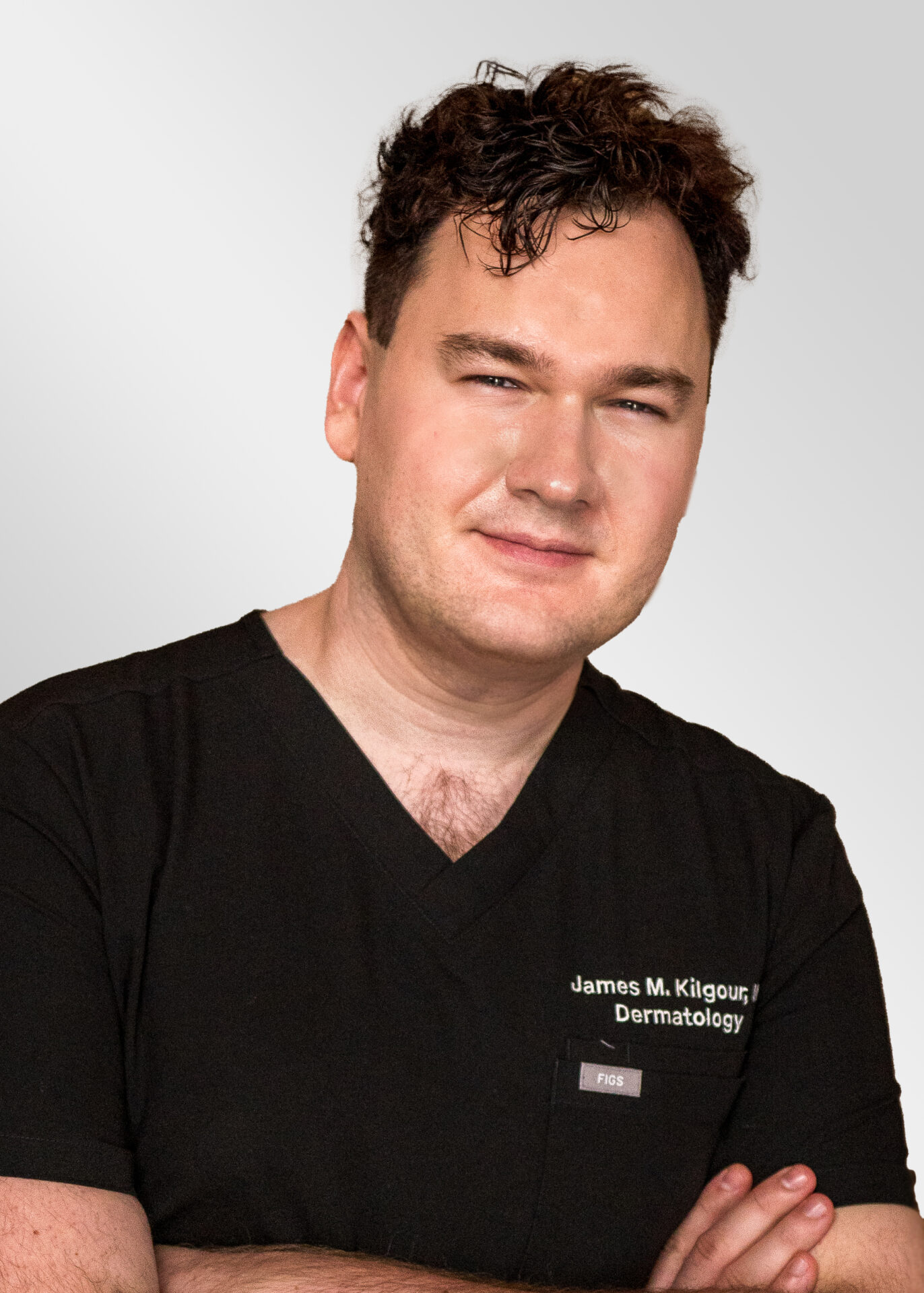
“I’ve seen remarkable improvements in my patients when we address scalp health as part of their overall hair loss treatment plan. The scalp environment is just as important as hormonal factors in determining hair growth success. Professional-grade serums and treatments can help restore some of the youthful characteristics of scalp tissue, creating better conditions for hair follicle function. When combined with appropriate medical treatments and lifestyle modifications, comprehensive scalp care can make a significant difference in treatment outcomes for menopausal hair loss.”
When Should You See a Dermatologist for Hair Loss?
Early intervention is key when dealing with menopausal hair loss, as hair follicles become increasingly difficult to revive once they’ve been inactive for extended periods. If you notice increased hair shedding, thinning around the part line, or overall volume loss, it’s important to seek professional evaluation promptly.
A dermatologist can perform comprehensive testing to rule out other causes of hair loss and develop a personalized treatment plan. This may include blood work to check for nutritional deficiencies, thyroid function, and hormone levels, as well as a detailed scalp examination to assess follicle health.
How Long Does It Take to See Results from Treatment?
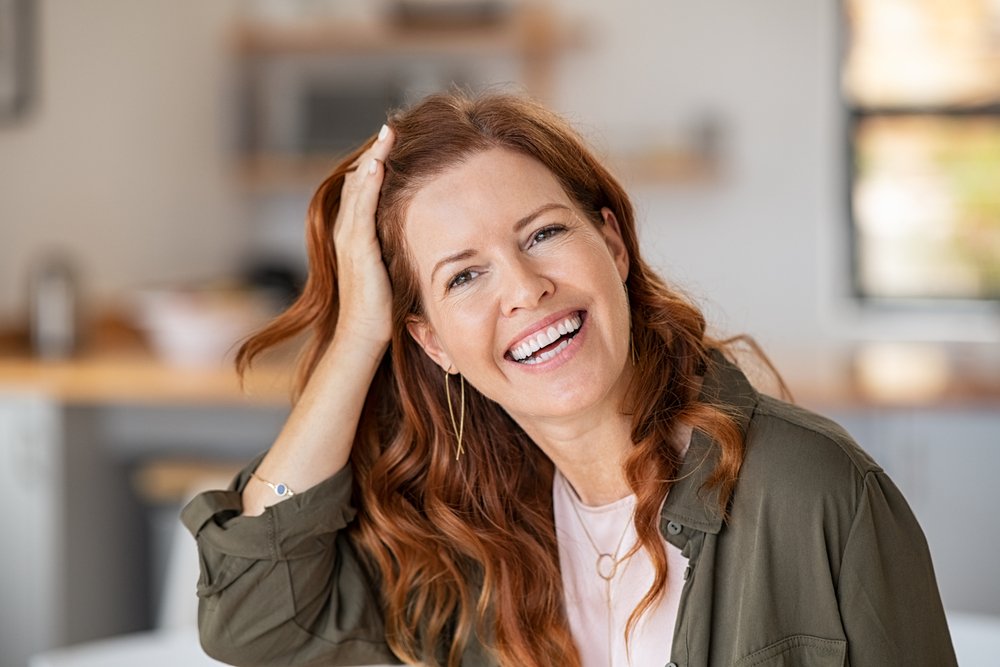 Hair growth is inherently slow, and it typically takes 3-6 months to see initial improvements from most hair loss treatments. This timeline reflects the natural hair growth cycle, which cannot be accelerated beyond certain biological limits.
Hair growth is inherently slow, and it typically takes 3-6 months to see initial improvements from most hair loss treatments. This timeline reflects the natural hair growth cycle, which cannot be accelerated beyond certain biological limits.
Consistency with treatment is crucial during this waiting period, as stopping treatment prematurely can result in loss of any progress made. Many women find it helpful to take progress photos and measurements to track subtle changes that might not be immediately apparent.
Menopausal hair loss doesn’t have to be an inevitable part of aging. By understanding the multiple factors involved and working with experienced providers to develop comprehensive treatment strategies, women can maintain healthier, fuller hair throughout this life transition and beyond.
If you have questions about your skin, schedule an appointment at Duncan Dermatology today!
